Volvo
|
1926 - Present |
Country: |
 |
|
Assar Gabrielsson and Gustaf Larson
Since the company was founded, Volvo has enjoyed a well deserved reputation for safety and quality. Volvo was born in the 1920's, the creation of two intensely patriotic Swedes. The scene was set, so the story goes, in a restaurant when the two leading characters - Assar Gabrielsson and Gustaf Larson - happened to meet for a meal. After-dinner discussion eventually strayed to the subject of cars in general, and of car manufacture in particular. American cars were acknowledged to be most popular in Sweden at that time, even though their high-speed engines and soft suspension were not especially suited to local conditions.
Gabrielsson and Larson agreed a car built specifically for Scandinavian climatic and road conditions would probably find a ready market. Such a car did not exist; so Gabrielsson, an outstanding salesman for the Swedish Ball Bearing Company (better known as SKF), through of the number of ball-bearings bought by the French motor industry. If France could build cars, why could not Sweden? Larson, with practical automotive engineering experience in English factories, had also asked himself much the same question. Neither could suggest any good reason why Sweden should not have its own car, and they decided to explore the idea further.
Soon Larson and several enthusiastic young engineers designed what they thought to be Sweden's ideal car. It was then that they began to appreciate the world of difference between designing a car and building it in quantity. Among the most critical problems were Sweden's lack of automotive engineering firms and the difficulty in raising finance. Although interest in the project was widespread, financiers were sceptical of its success, refusing to speculate on a locally-built car competing against imported models. Gabrielsson and Larson were not easily discouraged. Intending to produce a prototype and 10 pre-production cars, they combined their personal assets rather than abandon the project.
Building Cars The Volvo Way
It was realised the initial vehicles would have to be virtually hand-built and because of lack of funds complete manufacture of production models was impossible. Instead they chose to buy various major assemblies from, firms who already specialised, or were prepared to, in the necessary units. Commonly employed in the US, this method of producing cars was comparatively new to Europe, particularly on the scale Gabrielsson and Larson envisaged. Their firm was to be responsible, in effect, only for design and assembly of the vehicles, with the actual manufacture of the components done by outside contractors.
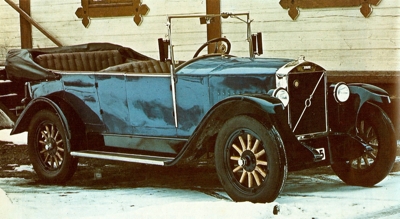
1928 Volvo OV4, which featured a 1944cc four-cylinder engine.
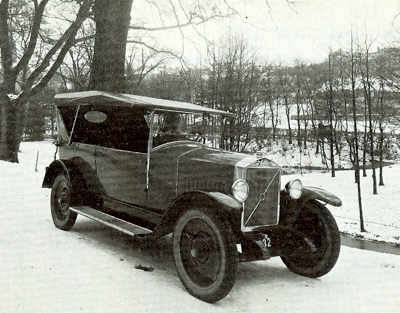
Another image of the Volvo OV4. The body was sheet-metal formed over an ash and red beach frame. The first cars were nicknamed Jacob.
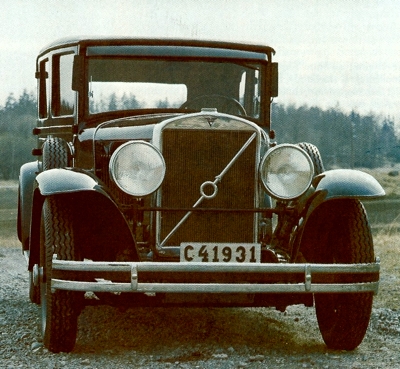
1931 Volvo PV650, which was fitted with a 3 liter six-cylinder engine.
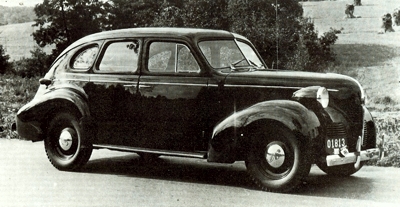
The Volvo six-cylinder PV60 was first seen in 1942, but was not put into production until 1946. Considered as one of the first 'Americanised' European cars, it was fitted with a three-speed gearbox with optional overdrive.
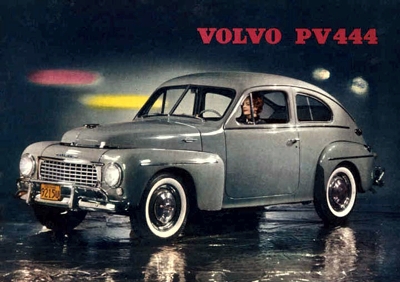
The Volvo PV444 was successful in the US market, and went a long way to establishing Volvo outside of Sweden.
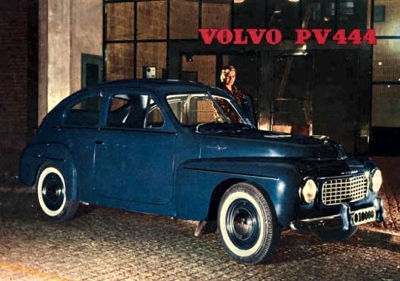
The Volvo PV444 developed an International reputation for solid quality construction and good manners.
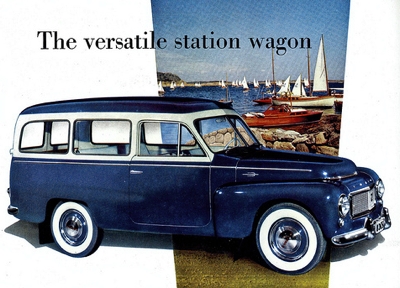
The Volvo PV445 was the wagon version, and also proved very popular.
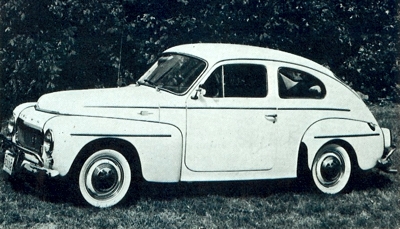
The Volvo PV544 proved incredibly popular, and 440,000 were manufactured between 1958 and 1965. It was based on the PV444.
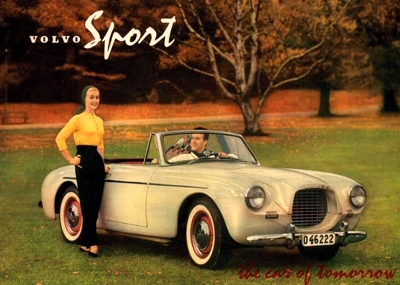
1956 Volvo P1900, an open sports car with glass-fibre body fitted with a 70 bhp version of the PV 1414 cc engine, and capable of 108 mph.
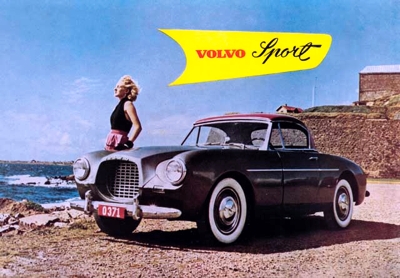
1956 Volvo P1900 was intended for export only, though a few were sold in Sweden. Only 67 were built.
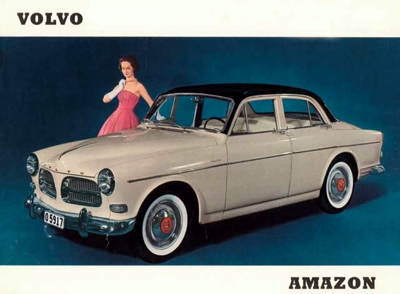
The Volvo Amazon was manufactured from 1956 to 1970, and introduced in the USA,as the 122S at the New York International Auto Show in April 1959.
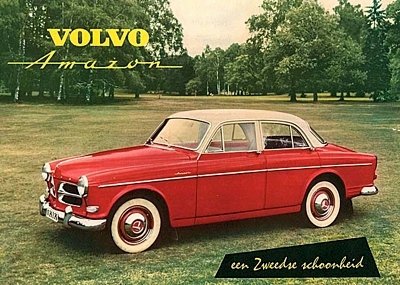
The Volvo Amazon quickly developed a reputation for being indestructable - a car that was built to last.
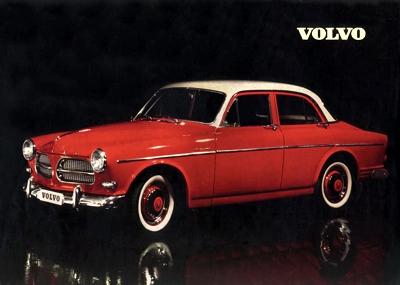
The Volvo Amazon Sport.
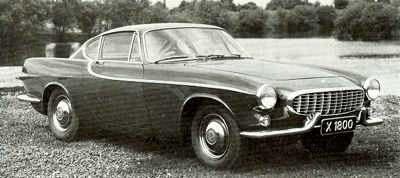
1964 Volvo P1800S.
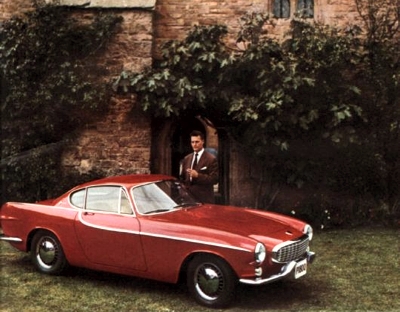
1964 Volvo P1800S. The bodies were built for Volvo by Jensen at West Bromwich, UK.
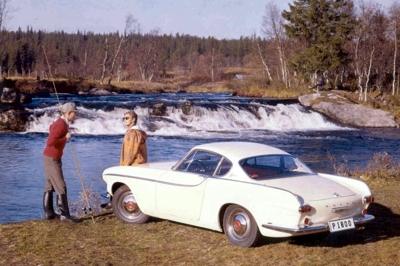
1964 Volvo P1800S.
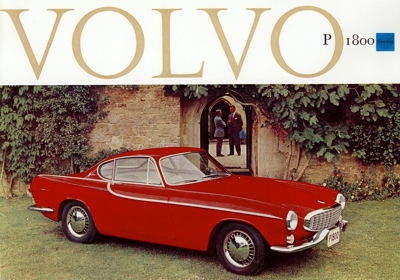
1964 Volvo P1800S.
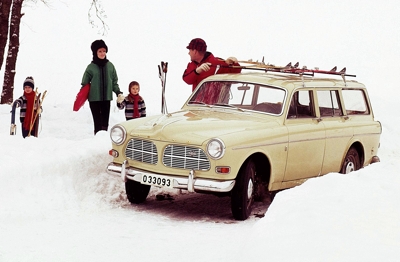
The Volvo 120 was also very popular in wagon form.
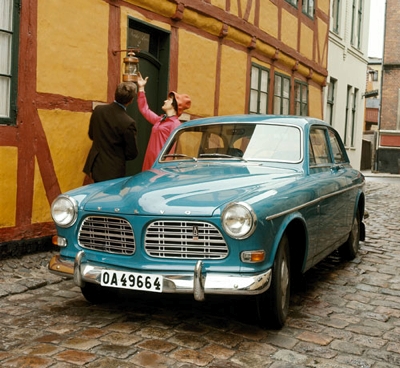
1970 saw the last model year of the Amazon/120. By then it had a 2 liter engine but had successively been replaced in the model programme by the more modern 142 and 144 Volvos.
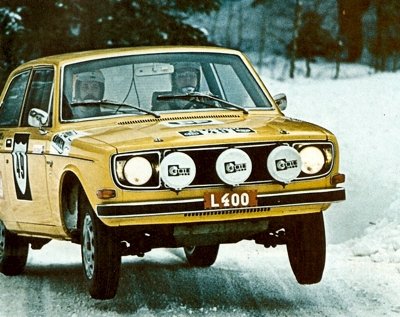
Volvo 142 lifts a wheel during the Swedish Rally.
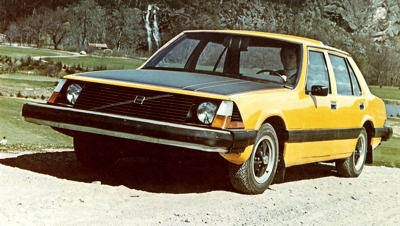
1973 Volvo VESC (Volvo Experimental Safety Car) - a rolling laboratory for the testing of safety systems.
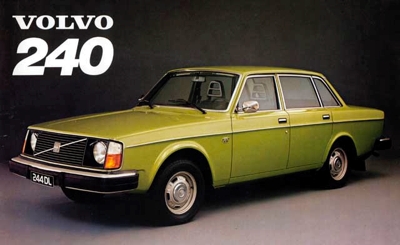
1974 Volvo 244DL.
|
Throughout Europe this was to become known as "building cars the Volvo way". The prototype and pre-production cars were built and proven, so much so that several large industrial firms subscribed to the venture, enabling full-scale production to begin. SKF was especially interested. Besides investing a considerable sum in the new-found AktieBolaget Volvo company, SKF also rented it premises in the Scandinavian Ball Bearing Company's factory at Gothenburg. Offices for the directors, Gabrielsson and Larson, were located in the factory's attic, as were those for the modest administrative and drawing staff. Volvo was in business.
A Product Of Superb Swedish Engineering
On April 14, 1927, the first Volvo production model left the assembly line. Available as either a tourer or sedan, the car had a 4-cylinder, 2-litre side-valve engine developing about 28bhp at 2000 rpm. It was a very contemporary vehicle, featuring such equipment as two-tone horn, 3-speed gearbox, balloon tyres and rear-wheel-only drum brakes. The sedan model also boasted such niceties as an ash-tray, flower vase and curtains on all windows. Thoroughly conventional in design, the Volvo was distinguished by its uncommonly high standard of engineering and finish. It was a typical example of Swedish precision engineering, and that became the basis of the firm's catch-phrase - "a product of superb SWEDISH engineering".
Far from apologising for its buying-out policy, Volvo made a point of emphasising it. The 1927 brochure, for example, drew attention to the many highly-respected manufacturers who supplied various components, including Bofors, SKF and Penta. Firms such as these were known around the world and their names spelt quality. In its formative years, therefore, Volvo gained invaluable publicity from its association with long-established companies.
Initial public acceptance of the car was, if anything, even better than hoped for and the directors optimistically forecast production of 1000 units in the first year, rising to 4000 in the second and no less than 8000 in the third. Unfortunately production forecasts, like those for the weather, sometimes go astray. Volvo's actual tally for 1927-1928 totalled only 297 units - not what had been hoped for, but sufficient to reinforce the directors' belief they were heading in the correct direction. They were.
Production soared during the following year, with 983 cars delivered. Also in 1928, Volvo's second production year, a previously unconsidered facet materialised. To the directors it was enough that the car was accepted and selling well in Sweden, and they had not considered its market potential outside their country. This view changed dramatically when 24 cars were sold in neighbouring Finland, initiating an export program which Volvo has vigorously expanded ever since.
The War Years
By 1939 the company was building 5000 cars and 4000 trucks annually, of which over 1500 were exported. By that time Volvo was solidly established, having bought the former SKF factory at Gothenburg in 1930. In 1935, with the business bursting at its seams and crying for expansion, it was decided to introduce Volvo shares on the stock exchange at Stockholm. Since then the firm has literally been owned by the Swedish people. Today Volvo has some 28,000 share-holders (more than its number of employees) and about 70 percent of those each hold less than 1000 shares.
With Sweden as a neutral: country during World War II, Volvo's resources and activities mainly centred around defence and assorted military purposes. The firm introduced a tractor and took over the Swedish Aero-Engine Company - later to build jet engines for SAAB's fighter planes. Despite its war-time commitments, though, Volvo had not forgotten its primary interest - cars.
The Volvo PV444
An entirely new design was conceived, only awTaiting the war's end to be introduced. Shown at a technical exhibition in Stockholm in 1944 was the Volvo PV444. This car, still resembling a 1948 Ford V8, was destined to become the backbone of Volvo's post-war automotive business. It featured such innovations as short-stroke ohv engine, independent front suspension and unit-built body.
Certainly a classic of its kind, the PV444 was an immediate success. Volvo's car sales soared to 10,000 by 1950, and were almost doubled again in the next five years. The car is still produced, still sells in respectable numbers, and still earns its place in Volvo's rally team. The latter is for good reason. Adding yet another laurel to its already brimming competition record, the car (now designated P-544) celebrated its 20th birthday with an outright win in the 1964
Acropolis Rally.
Like the
Volkswagen, the P-544 is seemingly ageless. Yet their respective, designs are in complete contrast, the German car being an example of unorthodoxy whereas the Swedish is quite conventional. In the mid-1950's Volvo supplemented the existing model with a larger, more modern model - variously known as the Amazon, 121 and 122. In keeping with Volvo's established practice, the new model relied on conventional design, quality engineering and excellent finish rather than gimmicky, eye-catching sales features. The car's solid, durable design and construction assured its success - not only in Europe, buit also in the USA.
The Second Largest Industrial Group In Scandinavia
Having seen his dream become reality, Assar Gabrielsson retired as managing director in
1956, and became chairman. His successor was a dvnamic young man, Gunnar Engellau, under whose direction the company thrived - maturing into an impressive empire. By the early 1960s Volvo had grown to become the second largest industrial group in all Scandinavia, comprising six wholly-owned subsidiaries, with 16 factories, directly employing over 20,000 people.
The range of activities was extremely diverse, though most were connected in some form or another with precision engineering. The automotive division alone accounted for six models of cars, five types of buses, 15 types of trucks, plus numerous special vehicles for commercial and military use. Other members of the Volvo group, some of which were originally sub-contractors that were taken over as the firm grew, made agricultural and industrial tractors, road graders and loading machines; a range of petrol, diesel, gas turbine and jet engines for automotive, marine and aeronautical purposes; lathes and assorted engineering equipment; gearboxes, final drive assemblies and, for the Volvo Penta Aquamatic marine unit, inboard/outboard drives; potato diggers and printing presses. All these are experiencing healthy growth, none more so than AB Volvo itself.
Building Outside Sweden
By
1962, annual production was more than 103,000 units, of which 52,000 were exported. Then
1963 saw several important developments. With production capacity strained to the limit at Gothenburg, Volvo opened new assembly plants at Dartmouth (Nova Scotia, Canada), which was the first Volvo-owned plant outside Sweden, and another at Ghent, Belgium.
A third factory was introduced at Torslanda, just 4.5 miles from the original Gothenburg site. Then considered to be one of the most modern of its type in the world, the Torslanda plant had capacity to produce 110,000 cars annually when working on a one-shift basis, or 200,000 with two-shifts. Floor area was 1,940,000 square feet, equivalent to 18 football fields, and the factory was one kilometre, or 5/8 of a mile long.
During
1963 Volvo produced 116,750 vehicles of which 58,654 were sold outside Sweden. Coinciding with the opening of the Torslanda factory, assembly of the Volvo coupe was transferred from England to the then-vacated Gothenburg plant. Previously the
P1800 was built by
Jensen Brothers in the UK because there was insufficient room for it in Sweden. However, in Volvo's traditional manner, the coupe bodies continued to be built in England, thence being shipped to Sweden for final assembly.
Volvo's commitment to greater structural integrity and safety design in cars crystallised in 1969, when the firm established its own criteria for an experimental safety vehicle. A fleet of ten of these 'rolling safety laboratories' were built. These were to be no theoretical vehicles, however. While the American safety vehicle requirements published in 1970 (and surprisingly similar to Volvo's own list) resulted in a number of armoured and overweight vehicles which would have smashed anything they nudged and guzzled fuel whenever they turned a wheel, Volvo were aiming for practical application of the results of their experiment.
The Volvo Experimental Safety Vehicles
The Volvo ESVs (experimental safety vehicles) combined all that Volvo had so far devised and incorporated into the 144 series, with other safety design already planned for the next series. The result was one large safety project that related to existing Volvo cars, and was therefore at the same time a production project. Different ESV's in the fleet featured different ideas, but the definitive vehicle added something like a score of positive safety improvements to the already well-wrought 144 structure.
More than 40 inches of deformation were designed in for frontal crashes of up to 50 mph. Front and rear bumpers were rubber faced, the ends sheathed in moulded plastic to prevent their hooking into anything, and mounted on telescoping shock absorbers so that the front bumper would flex seven inches in a 10 mph bump and the rear 3½ inches.
The grille sloped to deflect any unfortunate person struck by the front of the car. The headlamps were well sunk, and provided with a wash and wiper system. Brakes, discs all round, were fitted with an electronically controlled anti-lock system, and radial ply tyres were fitted for longer life and better roadholding. The rear suspension had a self-levelling system.
The windscreen-wipers were recessed so that a pedestrian flung on to the bonnet by the sloping grille would not be torn by the wiper arms. Hooked door-lock units the 200 series, incorporating basically the same telescopic bumper and frontal deformation principles perfected in the experimental cars, met at 40mph the US requirements for a 30 mph frontal collision, though the 40 mph crash created almost double the kinetic energy as the 30mph one.
The World's First Production Safety Vehicles
This characteristic alone reduced the stresses on occupants by twenty per cent compared with the 140 cars. Further innovations came in
1975 - most notably 'day-notice' lights which came on automatically with the ignition and stayed on to help other traffic perceive the car's approach: a stepped-bore master-cylinder giving almost full braking effect without increased pedal load with one brake cylinder out of operation: and rear seat belts as standard. The sum total of these safety characteristics, the need for many of which Volvo identified as much by accident analysis as by its own controlled experiments, has led the firm to claim that the 200 series cars were the world's first PSV's - production safety vehicles.
Many authorities would not dispute the claim - the day-notice lights and stepped-bore master cylinder won the Swedish AA Gold Medal in
1975, Spain gave the 200 series the Velocidad award for its safety provisions, an Italian Gold Medal was awarded as a result of a readers' poll in fourteen daily newspapers to find the car maker with the best reputation for products and services, a leading Norwegian magazine chose the 244 as Car of the Year for its safety, life-expectancy and trade-in value, and America's top motoring magazine chose the 244 as the best family car in all categories in competition with 45 other models.
In
1978 Volvo face-lifted their range, and gave the engines of both the 240 and 260 range higher compression ratios, raising output by around 8 bhp. In the late 1970s Volvo seemed firmly wedded to their collection of expensive and substantial, and of course very safe, cars, but this was meeting with some resistance from consumers, and Volvo's share of many export markets declined in 1977. A new small Volvo was added to the range this year - the 66GL, based on the then current DAF sedan and wagon and powered by a Renault 1300 engine, but with the interior redesigned by Fiore and a radical revision were installed to prevent doors bursting open in a crash.
In any type of collision at least two doors were designed to remain openable to allow rescuers into the car. A protective side moulding ran all the way round the
bodywork to guard against incidental
bodywork damage. Tubular reinforcement members were mounted laterally inside the doors to minimise the risk of intrusion by another vehicle hitting the side of the car - no more than four inches intrusion from another 30 mph vehicle. Doubled steel members were built into the window pillars and a doubled steel rollover bar was incorporated into the roof. In all types of accident the entire fuel system was designed to remain intact, with a deceleration-activated cut-out fuel pump positioned towards the rear to minimise the risk of petrol spillage and fire.
Fire retardant materials were specified for the interior. The interior was also stripped of all protrusions and padding was employed generously. Automatic three-point seat belts were installed. Head restraints popped up on the front seats in a collision. The backs of the front seats were thickly padded to minimise the risk of injury to rear passengers flung forwards in an impact. Rear seat head restraints were installed. The feel of the car was lightened and made more sensitive than in the weighty 144 series, and a spring-loaded steering wheel was fitted so that in the event of a frontal crash the steering wheel was instantly jerked six inches forward to the facia and at the same time away from the driver.
In some Volvo ESV's air bags were installed. Others had door-mounted seat belts, and others a semi-passive design which came into operation automatically when the car was started and the handbrake released. Various systems were tried to ensure that a disproportionately heavy load in the rear did not cause the headlamp alignment to dazzle oncoming traffic. And all the ESV's featured four-cylinder fuel-injection engines equipped with
exhaust gas recirculation systems and catalytic converters for maximum pollution control.
The Volvo 242, 244 and 245
Volvo was not the only car maker experimenting with safety at this time, but the firm certainly took things further earlier than any other European manufacturer, and the strictly practical attitude to its findings found expression in 1974 with the appearance of the 144 series replacements - the 242 two-door sedan, the 244 four-door, the 245 wagon and the 264 four-door. The 242/244/245 were powered by a new four-cylinder 2127cc engine with crossflow aluminum allow
cylinder head and belt-driven overhead camshaft. This engine appeared in two forms: with 8.5 to 1 compression ratio giving 97 bhp at 5000rpm, and with 9.3 to 1 compression ratio producing 123 bhp at 5750rpm; both accepted economical 93 octane petrol.
The 264 was fitted with a new 90-degree V6 unit displacing 2664cc, with aluminum alloy engine block with wet liners, aluminum
cylinder heads, and a chain-driven overhead camshaft between the
valves on each bank. Ignition was of the transistorised breakerless type, and the fuel system continuous-injection, these systems allowing a high standard of emission control with settings remaining accurate over a long period. This engine also used 93 octane fuel. Output was 140 bhp at 6000 rpm with a compression ratio of 8.7 to 1. But while Volvo had moved into a new generation of engines, they also utilised the knowledge which their ESV programme produced.
In 1974, and 1975 Volvo bought a controlling interest in the DAF car operation and established its own operation, Volvo Car BV, at Eindhoven, so resolving the firm's long-standing intention of getting into the smaller car market segment, though the DAF had been used as a basis for the first model. Meanwhile the Volvo 66 brought to the DAF-based two-door profile the familiar Volvo preoccupation with safety - telescopic steering shaft, inertia belts front and rear, front seat head restraints, split brake circuits, high-impact laminated screen, and rubber-faced bumpers. The overhead-valve engine produced 57 bhp at 5200 rpm. Brakes were power-assisted, the fronts being discs. The DAF De Dion rear axle was retained.
Pehr Gyllenhammar
The next car from Volvo's Dutch operation was the 343 introduced in 1977, This was larger than the 66, and not dissimilar from the Volvo Experimental Safety Car of 1973 in appearance, but it used the old DAF continuously variable transmission, and a 1397 cc four-cylinder engine, The next year Volvo offered the 343 with a manual gearbox option, however, in addition to the automatic transmission. By that time Volvo's car assembly plant at Kalmar had become a landmark in the use of technology to eliminate assembly lines as such and to increase the job-satisfaction of the employees.
Kalmar grew in the early 1970's out of a joint project by management under the newly-appointed managing director Pehr Gyllenhammar and labour representatives from all levels, They had as a working brief the experiences of Volvo at various of its other plants where ongoing efforts had been made to achieve a better working environment for employer and employee. The result at Kalmar was a new approach on both technical and social levels. The atmosphere of a small workshop was achieved by sub-dividing assembly into twenty-five separate team operations, each group consisting of about fifteen people, with further subdivision into groups of two or three for certain types of job.
The transport of bodies was on separate
battery-driven assembly carriers, not production lines, so that greater freedom in work planning was possible. In consultation with the foreman and production engineer the workers themselves suggested the working plan and division of responsibility for various operations, and job rotation was a feature of work patterns. In addition to assembly work, the workers were also responsible for materials supplies in their own team area and they played a part in continuous quality inspection. Work rates and breaks were varied to suit team and individual needs and wishes.
Core of the system was the assembly carrier, devised by Volvo, and controlled through electrical impulses from cables concealed in the floor. As well as a transport unit and working platform for the bodies during assembly (it could turn the bodies through 90 degrees on to their sides for easier working), the carrier also functioned as a transmitter of information to the factory's four computers which controlled overall production and monitored quality. Volvo safety design even played a part in these carriers - they had spring-loaded bumpers sensitive to a collision, and would stop from maximum speed within eight centimeters.
The Skovda Engine Plant
Volvo later tackled engine assembly in the same way, and in 1974 opened a new engine plant at Skovda employing groups of workers and assembly carriers instead of line assembly. Highly mechanised handling and electronic control of machining meant that women wereable to participate in what had previously been traditionally laborious engine shops. Perhaps a first for affirmative action in the motor industry, women were intended to have about forty per cent of the 1000 jobs - although we do not have any figures to ascertain if this was actually met, or exceeded.
At the start of 1977 it was thought that Sweden's two large car manufacturers, Saab and Volvo, would merge. The idea was considered strange by many who could not see the advantage for Saab in the proposed merger; their 99 series cars were establishing a good reputation, and the company was increasingly being regarded as a go-ahead innovative concern, helped by products like the Saab Turbo. Volvo, on the other hand, seemed to be going down something of a dead-end with the 200 series. In fact, the merger never materialised and Volvo's next step, after the Swedish government had refused them a multi-million development loan, was to sell forty per cent of their shares on the Norwegian stock exchange.
The arrangement was that the Norwegian government bought the majority of the shares in return for oil exploration rights in the North Sea - a strange arrangement, but Volvo did have a new petroleum division which could either use or sell the rights. In addition, the Norwegian government expected to have some new Volvo manufacturing plant constructed in Norway, to produce Volvo marine engines and a small 'city car'. Once again, however, many critics thought the whole plan unsound; labour, for example, was even more expensive in Norway than in Sweden.
Ford Motor Company's Premier Automotive Group
Volvo became part of the Ford Motor Company's Premier Automotive Group (PAG) on January 28, 1999. After the aquisition, Volvo set about creating a wider range of models - probably because Volvo was the only brand left in the group following the sale of Jaguar, Aston Martin and Land Rover. Ford decided to restructure plans for Volvo Cars, pushing it further upmarket alongside the lower end of Mercedes and BMW sedans, wagons, and SUV crossovers. The outcome was the luxurious second generation Volvo S80 and the new small premium crossover Volvo XC60.
Talks were held about the fate of Volvo Cars in the event of failure of US automakers, including Volvo's parent Ford. Swedish concerns mounted after repeated mass layoffs at Volvo, prompting Sweden to enter the spotlight to help its automotive industry. The government was asked to look into a possible state ownership of Volvo, or financial bailout for Volvo Cars and SAAB of GM. Eventually, AB Volvo responded to heated talks and decided that they did not want to see Volvo Cars fail, so they agreed to help Volvo cut costs through partnerships and even a possible share ownership amongst a larger consortium. AB Volvo repeated and stood stern that they will would buy back Volvo cars nor be sole majority owner. They were only willing to become part share owner of their erstwhile car unit.
Ford announced in December 2008 that it was considering selling Volvo Cars with an asking price of US$6 billion. The Swedish government was interested in helping with a possible Swedish acquisition, and it is believed that BMW AG of Germany, Investor AB of Sweden, Chinese investors, or Russian investors were all possible candidates for the purchase. Ford ultimately chose Geely Holding Group - although Geely had initially denied the plan, as did both Ford and Volvo.
Safety milestones:
- 1944 Safety cage
- 1944 Laminated windscreen
- 1954 Defroster vents for windscreen
- 1956 Windscreen washers
- 1957 Anchor points for 2–point safety belts front
- 1958 Anchor points for 2–point safety belts rear
- 1959 3–point front safety belts standard
- 1960 Padded instrument panel
- 1964 First rearward–facing child safety seat prototype tested
- 1966 Crumple zones front and rear
- 1966 Safety door–locks
- 1967 Safety belt rear seats
- 1969 Inertia reel safety belts
- 1971 Reminder safety belt
- 1972 3–point safety belts – rear
- 1972 Rearward–facing child safety seat
- 1972 Childproof locks on rear doors
- 1974 Multistage impact absorbing steering column
- 1974 Bulb integrity sensor
- 1975 Braking system with stepped bore master cylinder
- 1978 Child safety booster cushion
- 1982 "Anti–submarining" protection
- 1986 Three–point safety belt centre rear seat
- 1990 Integrated child safety cushion in centre rear seat
- 1991 SIPS – Side Impact Protection System
- 1991 Automatic height adjusting safety belt
- 1992 Reinforced rear seats in estate models
- 1995 Integrated child safety cushion outer rear seats
- 1997 ROPS – Roll Over Protection System (C70)
- 1998 WHIPS – Whiplash Protection System
- 1998 IC – Inflatable Curtain
- 2001 SCC – Volvo Safety Concept Car
- 2002 RSC – Roll Stability Control
- 2003 New Front Structure called Volvo Intelligent Vehicle Architecture (VIVA, S40, V50)
- 2003 Rear seat belt reminders (in S40 and V50)
- 2003 IDIS – Intelligent Driver Information System (in S40 and V50)
- 2003 Inauguration of Volvo's Traffic Accident Research Team in Bangkok
- 2004 BLIS – Blind Spot Information System (in S40 and V50)
- 2005 Introduction of DMIC (Door Mounted Inflatable Curtain, new Volvo C70)
- 2006 PCC – Personal Car Communicator (S80)
- 2006 CWBS – Collision Warning with Brake Support (S80)
- 2007 PPB – Power Park Brake (S80)
- 2007 DAC – Driver Alert Control (V70, XC70)
- 2009 City Safety – Automatically stop car at speeds below 19 mph (31 km/h) if obstruction is detected in front of car (XC60)
- 2010 Pedestrian Detection with auto brake (New S60)
Also see: Volvo Car Reviews |
Volvo Color Codes |
Volvo Specifications |
The History of Volvo (USA Edition)



